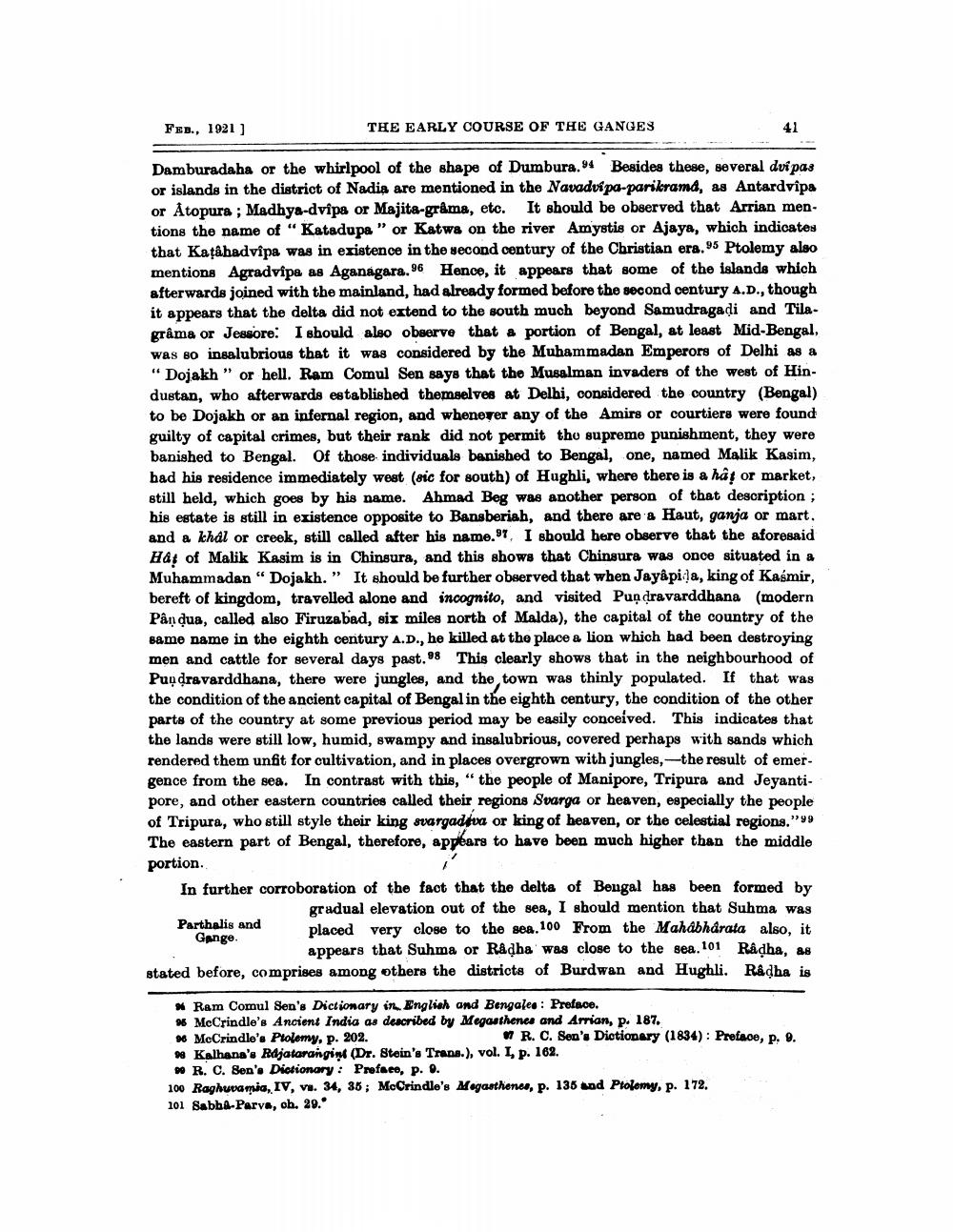________________
FEB., 1921]
THE EARLY COURSE OF THE GANGES
Damburadaha or the whirlpool of the shape of Dumbura." Besides these, several dvi pas or islands in the district of Nadia are mentioned in the Navadvipa-parikramd, as Antardvipa or Atopura ; Madhya-dvips or Majita-gråma, etc. It should be observed that Arrian mentions the name of " Katadupa " or Katws on the river Amystis or Ajaya, which indicates that Katahadvipa was in existence in the second century of the Christian era.95 Ptolemy also mentions Agradvipa as Aganagara.96 Hence, it appears that some of the islands which afterwards joined with the mainland, had already formed before the second oentury A.D., though it appears that the delta did not extend to the south much beyond Samudragadi and Tilagrâma or Jessore. I should also observe that a portion of Bengal, at least Mid-Bengal, was so insalubrious that it was considered by the Muhammadan Emperors of Delhi as a "Dojakh " or hell. Ram Comul Sen says that the Musalman invaders of the west of Hindustan, who afterwards established themselves at Delhi, considered the country (Bengal) to be Dojakh or an infernal region, and whenever any of the Amirs or courtiers were found guilty of capital crimes, but their rank did not permit the supreme punishment, they were banished to Bengal. Of those individuals banished to Bengal, one, named Malik Kasim, had his residence immediately west (sic for south) of Hughli, where there is a hãy or market, still held, which goes by his name. Ahmad Beg was another person of that description ; his estate is still in existence opposite to Bansberiah, and there are a Haut, ganja or mart. and a khal or creek, still called after his name.97, I should bere observe that the aforesaid Hat of Malik Kasim is in Chinsura, and this shows that Chinsura was once situated in a Muhammadan "Dojakh." It should be further observed that when Jayapica, king of Kasmir, bereft of kingdom, travelled alone and incognito, and visited Pundravarddhana (modern Pândua, called also Firuzabad, six miles north of Malda), the capital of the country of the same name in the eighth century A.D., he killed at the place a lion which had been destroying men and cattle for several days past. 98 This clearly shows that in the neighbourhood of Pundravarddhana, there were jungles, and the town was thinly populated. If that was the condition of the ancient capital of Bengal in the eighth century, the condition of the other parts of the country at some previous period may be easily conceived. This indicates that the lands were still low, humid, swampy and insalubrious, covered perhaps with sands which rendered them unfit for cultivation, and in places overgrown with jungles,--the result of emer. gence from the sea. In contrast with this," the people of Manipore, Tripura and Jeyantipore, and other eastern countries called their regions Svarga or heaven, especially the people of Tripura, who still style their king svargad va or king of heaven, or the celestial regions."99 The eastern part of Bengal, therefore, appears to have been much higher than the middle portion. In further corroboration of the fact that the delta of Bengal has been formed by
gradual elevation out of the sea, I should mention that Suhma was Parthalis and Gange.
placed very close to the sea.100 From the Mahabharata also, it
appears that Suhma or Rådha was close to the sea. 101 Rådha, 28 stated before, comprises among others the districts of Burdwan and Hughli. Radha is
* Ram Comul Sen's Dictionary in English and Bengales : Proface. * McCrindle's Ancient India as described by Megasthenes and Arrian, p. 187. * McCrindle's Ptolemy, p. 202.
MR. C. Son's Dictionary (1834): Preface, p. 9. 9 Kalhana's Rdjatarangin (Dr. Stein's Trans.), vol. I, p. 162. # R. C. Sen'. Dictionary: Prefaco, p. 0. 100 Raghuvamia, IV, v. 34, 35; Morindle's Megasthenes, p. 136 kod Ptolomy, p. 172. 101 SabbA-Parva, ch. 29.




